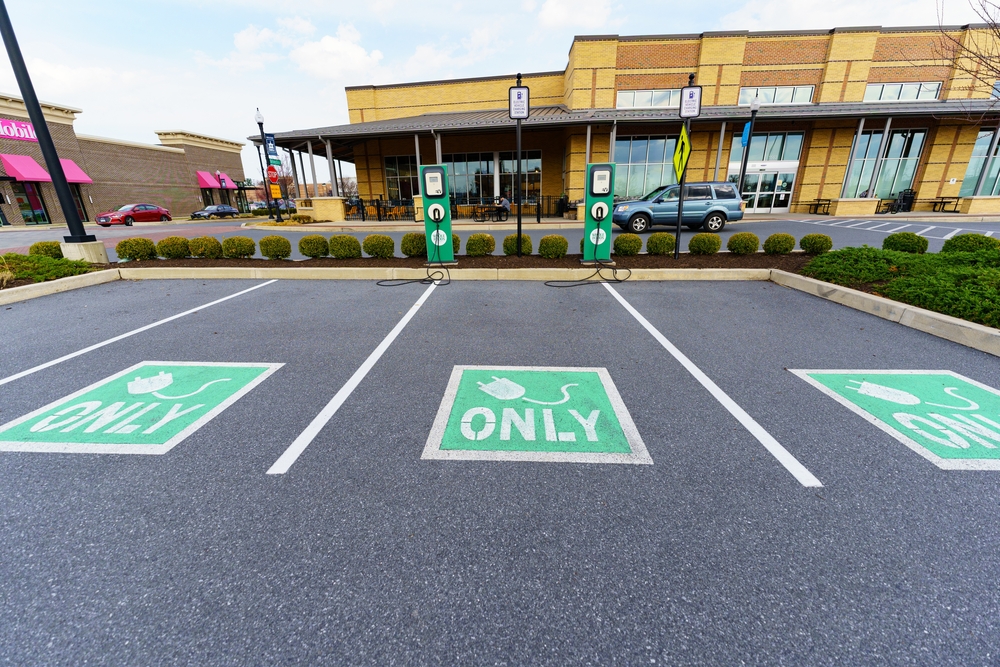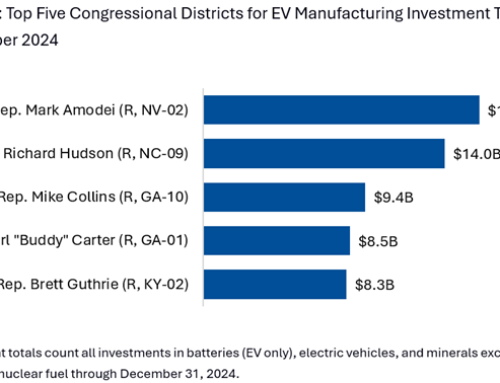
Image Source: Shutterstock
2024 was an action-packed year for electric vehicle (EV) policy and the EV market. 2025 promises to be equally busy as we transition to a new administration and Republicans take control of both houses of Congress. EV Hub will continue to bring you all the updates and latest developments but, in the meantime, I chatted with a few of my colleagues to weigh in on the work done on EVs this year and what to watch out for in 2025. In this digest, we hear from Atlas Policy Analysts Kelsey Blongewicz and Daniel Wilkins, Project Manager John Kuna, Senior Policy Analyst Ben Sharpe, and Founder Nick Nigro.
What is an EV development that took you by surprise in2024?
Kelsey: I don’t know if it took me by surprise, but I thought the progress in medium and heavy-duty electrification was fun to watch this year. The PACT Coalition launched, EPA finalized Phase 3 regulations for commercial trucks and buses, and the Joint Office released their National Zero-Emission Freight Corridor Strategy. A coalition of states received Climate Pollution Reduction Grant funding for I-95 MDHD charging infrastructure, both clean school buses and transit buses got public funding boosts, and MDHD vehicle sales continued to climb, with Q3 2024 setting a record high. It has been interesting to follow these and other developments in this emerging technology.
Daniel: I was surprised to see Florida emerge as the nation’s second-largest market for new EV sales from Q1 2024 – Q3 2024, right behind California, yet approach EV state policy so differently. In 2024, California not only maintained its first-place sales ranking but also enacted a range of supportive measures such as streamlined permitting for curbside charging (AB 2427) and technical assistance programs for fleet electrification (AB 2900). By contrast, Florida did pass some foundational laws like preempting local regulation of EV charging stations (SB 1084) but was unable to pass more advanced policies such as vehicle-to-grid planning requirements (SB 1212) and alternative fuel vehicle tax rebates (SB 650).
John: The PACT announcement was a very welcome development in transportation electrification. It was promising to see some of the most prominent truck manufacturers announce a partnership to accelerate the transition toward electric medium and heavy-duty vehicles.
Ben: Good surprises: there continues to be healthy investment and development work to get tractor truck-specific charging stations up and running. Companies such as Greenlane, WattEV, and TeraWatt have opened stations in the past year. Also, e-truck fleet leaders such as Amazon continue to amass major mileage (they have 20,000 Rivian delivery vans on the road!).
Not-so-good surprise: e-truck prices (especially for larger tractor trucks) are trending in the wrong direction. Oddly enough, prices for comparable trucks in Europe (often from the same OEM parent companies) are getting less expensive in Europe (CARB memo). Whatever the root cause, higher prices for e-trucks are making the TCO picture much murkier for fleets in the U.S.
Nick: A lot happened in ’24 that’s for sure. I can’t say I’m surprised by the bankruptcies, or the market exits because that’s part of the game when you’re transforming an industry. One thing that has and continues to surprise me is Tesla’s stock price. They’re up 70% in the last year and now have a market cap around $1.4T, which puts them at #8 in the world. Wow.
2024 was an engaging year for transportation electrification and EVs. What is one project or work achievement from this year that you are especially proud of?
Kelsey: Launching the NEVI Awards Dashboard in partnership with NASEO, AASHTO, and the Joint Office felt particularly momentous. Tracking state awards in one place highlights the progress that states are making in implementing this program and building out a reliable, affordable, equitable national EV charging network. NEVI has been such an important and talked-about program over the past couple of years and this new dashboard lets everyone follow this progress and find charging opportunities as more and more NEVI-funded stations come online.
Daniel: I’m really proud of the recent total cost of ownership (TCO) analysis we conducted in March that directly compared popular gasoline vehicles with their EV counterparts over a seven-year ownership cycle. This project went beyond just sticker prices to look at fuel, maintenance, insurance, and even federal EV tax credits. Our findings showed that EVs can deliver significant cost savings – often thousands of dollars less over that ownership period – compared to some of the most popular internal combustion engine vehicles on the market today.
By leveraging our Fleet Procurement Analysis Tool (FPAT) and making the results public, we’ve equipped consumers, fleet managers, and policymakers with tangible evidence that EVs aren’t just cleaner and easier to maintain, but can also be a smart financial decision over the long run. It helps to shift the public conversation from “Can I afford an EV?” to “Can I afford not to?”
John: Very proud of the series of case studies I authored that reviewed the first states to implement NEVI. Those findings, some of which are still in the process of being published, gave insights for state DOTs about early lessons learned and best practices being developed in RFP/solicitation design, outreach to utilities and potential NEVI site hosts and charging companies, and deployment of charging infrastructure.
Ben: I’m very proud of the great team effort we put in to win the MHDV charging study from the Maryland Department of the Environment. I’m excited to work with a diverse group of partners, including EV Advisors, the University of Maryland, and EV Noire. It’s great to be expanding our MHDV charging analytical prowess at the state level, and I’m very grateful that this work for MDE will stand on the shoulders of the excellent previous work we’ve done in the space (e.g., Colorado study and the Advanced Clean Trucks work).
Nick: Releasing the NEVI awards dashboard as part of our work with NASEO, AASHTO, and the Joint Office of Energy and Transportation was a big highlight for me. Atlas has always tried to democratize access to information. With this dashboard, we’re shining a bright light on the most important EV charging infrastructure program in U.S. history. The dashboard shows the remarkable progress state DOTs made this year, which deserves our kudos. A personal highlight for me was testifying to the House Transportation and Infrastructure Subcommittee on Highways and Transit.
As the new administration takes charge, what will you be closely watching in transportation electrification or climate policy in the next year?
Kelsey: I’ll be watching state governments! As we discussed earlier this year, there has been an increasing amount of action in state legislatures surrounding transportation electrification and I would expect state policy to have an even bigger focus as a new administration takes over at the federal level. Additionally, between NEVI formula funding, Charging and Fueling Infrastructure Grants, and numerous other programs and awards that have gone to state, local, and tribal governments over the past couple of years, I am excited to see the projects that come from this funding. A lot of momentum has been built up at the state level this year and I hope it will continue to grow in 2025.
Daniel: I’ll be closely watching to learn the fate of the federal tax credits, particularly the 45W tax credit for EVs and the 30C credit for charging infrastructure. These incentives have played a big role in encouraging businesses and consumers who are taking their first steps toward electrification, enabling fleets to bring down upfront sticker prices and helping private buyers offset the expense of home or workplace charging installations.
Should these credits be repealed in the near future, the cost-of-ownership advantages and technological improvements in EVs will still push the market forward, but would likely slow the scale and speed at which we see electrification take place. Learning what the next administration plans on doing with the tax credits will give us a better idea of how quickly and smoothly the next wave of EV growth will go.
John: I will be keeping tabs on executive actions that could impact the CFI competitive grant program for charging infrastructure, legislative actions that could impact the investments laid out in the Bipartisan Infrastructure Law and the Inflation Reduction Act, and state actions to fund climate and environmental efforts.
Ben: As the new administration transitions in, I’ll be carefully watching the policy landscape and escalating tensions between CA (+ other environmentally progressive states) and the federal government. Key policies to watch include the Advanced Clean Truck Regulation, as well as EPA’s Phase 3 GHG rule. The ACT has been adopted in CA and several other states but is already facing headwinds due to barriers such as the high prices of e-trucks and lack of a robust charging infrastructure network. In the past is prologue, the EPA’s Phase 3 rule is likely to be a target of the new administration, just as the Phase 2 regulation was rolled back in several key ways during the first Trump administration. The Phase 3 regulation’s stringency is premised on the uptake of a significant amount of zero-emission MHDVs, and I imagine we’re going to see the new EPA leadership make a major attempt to pull back on the stringency.
Nick: I will be laser focused on the EV tax incentives for manufacturers and consumers. These policies have sparked huge growth in investments in U.S. manufacturing and EV adoption. They’re a critical piece of the puzzle for us to catch up and compete with China for global leadership in the vehicle market.

